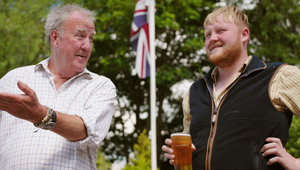
Zelenskyy and the Sweatshirt That Strengthened Estonia’s ‘Will to Fight’

Above: Volodymyr Zelenskyy speaking in the Estonian parliament. Photographer: Raul Mee / Estonian Government Communications Bureau
In February 2025, conservative US broadcaster Brian Glenn questioned why Volodymyr Zelenskyy wasn’t wearing a suit during his Oval Office meeting with Donald Trump – implying that his military fatigues were out of place. But for many, the critique only amplified the symbolism. Zelenskyy’s refusal to dress for the room spoke volumes. In his trademark military gear, he embodied a leader still at war, three years after Russia launched a full-scale invasion of Ukraine. Zelenskyy didn’t need tailoring to make a statement. The uniform said everything.
This was just one reminder of how the Ukrainian president’s attire has symbolic depth. Since the start of Russia’s invasion of Ukraine in 2022, Zelenskyy has consistently cemented his image as that of a capable war leader rather than a trifling politician. When he stood up in front of the Estonian parliament in an olive green sweatshirt that read ‘Kaitsetahe’ – it was a historic act for the people of the Baltic nation, as well as the broader global community that stands with Ukraine.
The powerful Estonian phrase roughly translates as ‘will to fight’, which became the theme of the speech Zelenskyy made that day, some of it in Estonian. And putting the sweatshirt on that platform was a surprise even to the people who made it.
“We didn’t tell him to wear it in front of Parliament,” recalls Helmuth Martin Reisner. As the Estonian Defence Ministry’s head of the Defence Resolve Department, he was one of the key figures behind the garment. “It was just presented to him with the message that the sweatshirt was inspired by him, that we’re working on defence willingness, and that his example has been inspirational – it’s unified Estonians and resonated in the West too. He decided to put it on and give his speech on the spot. He was actually a little late to his televised address to Parliament, but he was using that time to rehearse the speech in Estonian. Then he delivered it – and it kind of blew everybody away that he did it.”

Above: Kaja Kallas presents the sweatshirt to Zelenskyy. Photographer: Raul Mee / Estonian Government Communications Bureau
The sweatshirt had been a gift presented from one head of state to another by Kaja Kallas, prime minister of Estonia (2021–2024) and EU vice president / foreign affairs and security policy. “She gifted the sweatshirt to Zelenskyy, without any intention or guarantee that he would do something with it,” says T&P London creative director Kareem Shuhaibar, who had worked on getting the sweatshirt to this point. “It was simply a gift… He surprised everyone.”
“I think the most important thing is that he wore it on purpose, to spark a reaction,” says Kareem. “It’s a powerful word in Estonia, and I think it conjured up a lot of emotion.”
The result was way out of scale with the effects you might expect to achieve with a single word of white text on an olive green crewneck. “It became a two-way conversation – a sweatshirt that actually created a conversation without saying anything,” says Kareem. “People spoke back in their support, towards defence willingness and towards Ukraine."
In February 2022 after Russia invaded Ukraine, Estonia quickly took action. As another nation bordering Russia, it was “called into action,” as Martin remembers it, to form the Defence Resolve Department. “We realised that if we want to motivate people to serve, they need to understand that the society they're protecting values them.”
To help encourage Estonians’ ‘will to fight’, Martin knew that creativity was vital to the department’s messaging. Fortunately, he soon found a brother in arms with the skills to assist. While on military reservist training in May 2023, he served as section commander with his deputy Heiki Urbala, whose day job is creative director at the creative agency Taevas.
Heiki had joined the Estonian Defence League on 24th February 2022 (the same day the Ukraine war started). Martin had already been in the reservist force for many years.

Above: Helmuth Marin Reisner and Heiki Urbala as reservists during Spring Storm 2023, a military rehearsal in Estonia
Soon after the Defence Resolve brief was created, Martin and Heiki began brainstorming symbolic ways to increase support for defence readiness among Estonians. They were throwing around ideas like messaging on milk cartons, but it was when the subject of fashion came up that things got exciting.
“At that time, Zelenskyy had effectively become a fashion icon because of what he wore,” says Heiki. It didn’t take long to get to the idea of a garment that reflected the Ukrainian president’s aesthetic, but with a uniquely Estonian twist. ‘Kaitsetahe’ – ‘Will to Fight’ – became the message, while the medium was a riff on an existing icon. “We’d make it in Zelenskyy green,” says Heiki.
Execution was simple. It didn’t take much of a push from Martin to convince Estonian streetwear brand MARAT to get some printed up. But originally he was just thinking it would be a limited run. A few for people in his department to wear and maybe some extras to give to special supporters of the department’s mission.
“Then, when we heard that Zelenskyy was coming,” says Martin. “It was this spontaneous idea on the spot – we thought it would be really, really cool if he wore our sweatshirt, which was inspired by him, and if he did it in front of parliament.”
He made a few calls at the last minute and Kaja Kallas ended up presenting Zelenskyy with the sweatshirt. “We didn’t tell him to wear it in front of Parliament. It was just presented to him with the message that it was inspired by him, that we’re working on defence willingness, and that his example has been inspirational – it’s unified Estonians and resonated in the West too.”
The power of this symbol was not lost on the Ukrainian leader. He decided to put it on and give his speech with its message front and centre – defiance, solidarity and shared resistance.
After the speech, the ‘Kaitsetahe’ project took on a whole new scale. “To have the Ukrainian president say something about defence willingness in Estonia, and to wear the sweatshirt in front of the Estonian Parliament – that was such a symbolic moment. It’s hard to put into words what it meant,” says Martin.
MARAT and the creatives behind the project suddenly had a new task on their hands. “It became clear that demand was much higher than the four I had left in reserve,” laughs Martin. “So we decided to put it on sale.”
While the purpose of the garment was to promote defence resolve, MARAT were also keen to agree to make a donation of €10 from each €55 sweater to the Estonian Wounded Warriors Association, helping those who have served the Estonian state. “I think the initial thought was that it wouldn’t be such a big deal – they ordered maybe 100 hoodies to start with,” says Martin. But thanks to Zelenskyy’s modelling, over 10,000 have now been sold.
“The CEO of MARAT mentioned that after Zelenskyy wore the shirt, his office was inundated with phone calls from people asking how to buy it,” says Kareem.
‘Kaitsetahe’ has gone far beyond MARAT now. Around two months after Zelenskyy’s adoption of the slogan, Balbiino, one of Estonia’s leading ice‑cream makers, released a vanilla-flavoured ‘reservist ice cream’ in collaboration with the ‘Kaitsetahe’ campaign, featuring camouflage packaging and donating proceeds to the reservists’ fund.
To date, over 230 brands overall have joined the campaign, launching products (including ice‑cream, milk, supplements, etc.) using the military-patterned ‘digilaik’ camouflage as part of the wider ‘Kaitsetahe’ campaign. By the summer of 2024, over half a million ‘digilaik’ products had been sold, generating more than €50,000 for the Reservists’ Fund . “Amazing for something that started with a sweatshirt,” notes Martin. “It wasn’t just a one-off. We’re doing the next iteration during Reserve Forces Week. There are more and more products coming online now.”
And that's not to mention copycats. The ‘will to…’ format of the slogan has become something of a meme in Estonia. “Other ministries started adapting it – ‘Will to defend’ became ‘Will to pay taxes,’ ‘Will to study,’ ‘Will to…’ all kinds of things… Now it’s a shorthand,” says Martin (and that’s just the safe for work renditions).
As a result of this iconic garment, embraced by a historic leader, the ‘Kaitsetahe’ message has reached over 900,000 Estonians – over 70% of the country’s population. And according to the Ministry of Defence’s latest figures 70% of Estonian residents would definitely or rather be willing to participate in defence activities to the best of their abilities and skills. While the war in Ukraine continues, the willingness of Estonians to participate in defence activities has not changed over the last year and continues to be high.
For a defence project using public resources, Heiki is keen to underline the challenges: “Most of the [Ministry of Defence] budget goes to buying arms for the Estonian forces. The team behind all of this was relatively small – Kareem on his side, me from Taevas, and Martin from the ministry.” But the results have been seismic.
“We weren’t trying to do a big, blockbuster campaign,” says Kareem “To have Volodymyr Zelenskyy involved for zero dollars is unthinkable in today’s world. But we managed to do that.”
How? “One word that comes to me is that it was very guerrilla,” concludes Kareem. “Almost army-esque. We infiltrated parliament with a sweatshirt. We literally lived the DNA of defence, even down to the way we executed the campaign. The tactic was very guerrilla, unconventional, against all odds.”
As a government client, Martin couldn’t have hoped for a more fruitful collaboration with ad agencies and a fashion brand. “I’m really proud of what this campaign has achieved,” he says. “The media coverage, the awards – those are great. But they’re not what I work for. What matters is that this initiative has had a meaningful and measurable impact on public support for national defence. And that’s a good outcome on both sides.”















